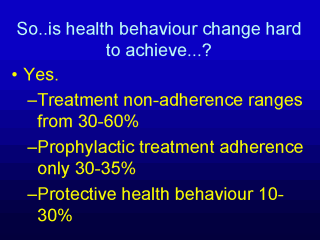| front |1 |2 |3 |4 |5 |6 |7 |8 |9 |10 |11 |12 |13 |14 |15 |16 |17 |18 |19 |20 |21 |22 |23 |24 |25 |26 |27 |28 |29 |review |
 |
As you probably realise by now,
much of your work as a doctor will revolve around getting your patients to change their
behaviour. And you will also have realised that such change is quite hard to achieve,
easier in some cases than others,. A momentís glance at some health-related data will
reveal the extent of the problem. Peoplesí adherence to treatment is usually not much better than 505; that is, one in two patients do not follow doctorsí instructions regarding treatment. For treatment regarding preventive measures, such as exercise or smoking cessation, the adherence rate drops to a low one in three, while for protective health behaviours, such as wearing a condom when having sexual intercourse, the adherence rate falls to as low as one in ten. This is not a very encouraging picture. And yet, behaviour change is probably the best way to deal with the problem of chronic disease. |